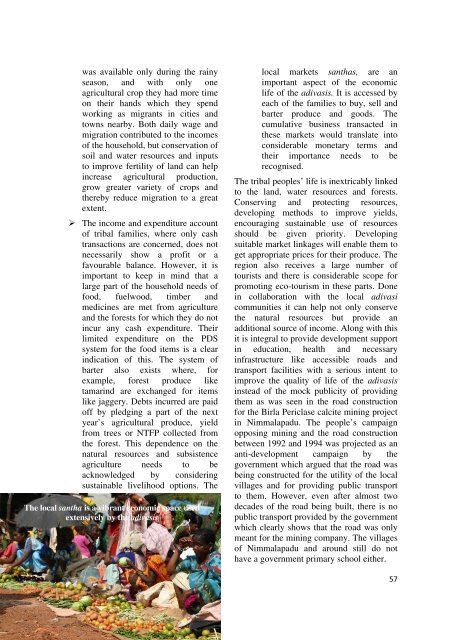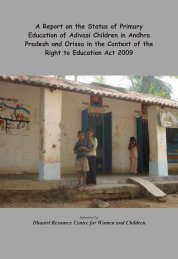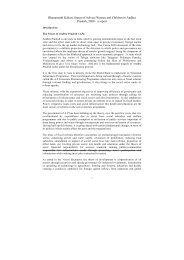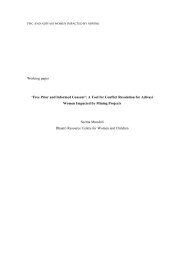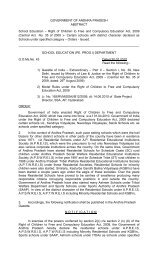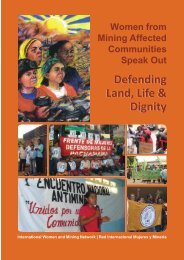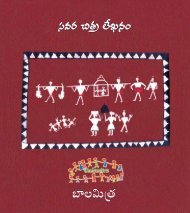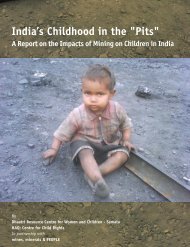Impacts of Government Policies on Sustenance of Tribal ... - Samata
Impacts of Government Policies on Sustenance of Tribal ... - Samata
Impacts of Government Policies on Sustenance of Tribal ... - Samata
You also want an ePaper? Increase the reach of your titles
YUMPU automatically turns print PDFs into web optimized ePapers that Google loves.
was available <strong>on</strong>ly during the rainyseas<strong>on</strong>, and with <strong>on</strong>ly <strong>on</strong>eagricultural crop they had more time<strong>on</strong> their hands which they spendworking as migrants in cities andtowns nearby. Both daily wage andmigrati<strong>on</strong> c<strong>on</strong>tributed to the incomes<str<strong>on</strong>g>of</str<strong>on</strong>g> the household, but c<strong>on</strong>servati<strong>on</strong> <str<strong>on</strong>g>of</str<strong>on</strong>g>soil and water resources and inputsto improve fertility <str<strong>on</strong>g>of</str<strong>on</strong>g> land can helpincrease agricultural producti<strong>on</strong>,grow greater variety <str<strong>on</strong>g>of</str<strong>on</strong>g> crops andthereby reduce migrati<strong>on</strong> to a greatextent. The income and expenditure account<str<strong>on</strong>g>of</str<strong>on</strong>g> tribal families, where <strong>on</strong>ly cashtransacti<strong>on</strong>s are c<strong>on</strong>cerned, does notnecessarily show a pr<str<strong>on</strong>g>of</str<strong>on</strong>g>it or afavourable balance. However, it isimportant to keep in mind that alarge part <str<strong>on</strong>g>of</str<strong>on</strong>g> the household needs <str<strong>on</strong>g>of</str<strong>on</strong>g>food, fuelwood, timber andmedicines are met from agricultureand the forests for which they do notincur any cash expenditure. Theirlimited expenditure <strong>on</strong> the PDSsystem for the food items is a clearindicati<strong>on</strong> <str<strong>on</strong>g>of</str<strong>on</strong>g> this. The system <str<strong>on</strong>g>of</str<strong>on</strong>g>barter also exists where, forexample, forest produce liketamarind are exchanged for itemslike jaggery. Debts incurred are paid<str<strong>on</strong>g>of</str<strong>on</strong>g>f by pledging a part <str<strong>on</strong>g>of</str<strong>on</strong>g> the nextyear’s agricultural produce, yieldfrom trees or NTFP collected fromthe forest. This dependence <strong>on</strong> thenatural resources and subsistenceagriculture needs to beacknowledged by c<strong>on</strong>sideringsustainable livelihood opti<strong>on</strong>s. TheThe local santha is a vibrant ec<strong>on</strong>omic space usedextensively by the adivasislocal markets santhas, are animportant aspect <str<strong>on</strong>g>of</str<strong>on</strong>g> the ec<strong>on</strong>omiclife <str<strong>on</strong>g>of</str<strong>on</strong>g> the adivasis. It is accessed byeach <str<strong>on</strong>g>of</str<strong>on</strong>g> the families to buy, sell andbarter produce and goods. Thecumulative business transacted inthese markets would translate intoc<strong>on</strong>siderable m<strong>on</strong>etary terms andtheir importance needs to berecognised.The tribal peoples’ life is inextricably linkedto the land, water resources and forests.C<strong>on</strong>serving and protecting resources,developing methods to improve yields,encouraging sustainable use <str<strong>on</strong>g>of</str<strong>on</strong>g> resourcesshould be given priority. Developingsuitable market linkages will enable them toget appropriate prices for their produce. Theregi<strong>on</strong> also receives a large number <str<strong>on</strong>g>of</str<strong>on</strong>g>tourists and there is c<strong>on</strong>siderable scope forpromoting eco-tourism in these parts. D<strong>on</strong>ein collaborati<strong>on</strong> with the local adivasicommunities it can help not <strong>on</strong>ly c<strong>on</strong>servethe natural resources but provide anadditi<strong>on</strong>al source <str<strong>on</strong>g>of</str<strong>on</strong>g> income. Al<strong>on</strong>g with thisit is integral to provide development supportin educati<strong>on</strong>, health and necessaryinfrastructure like accessible roads andtransport facilities with a serious intent toimprove the quality <str<strong>on</strong>g>of</str<strong>on</strong>g> life <str<strong>on</strong>g>of</str<strong>on</strong>g> the adivasisinstead <str<strong>on</strong>g>of</str<strong>on</strong>g> the mock publicity <str<strong>on</strong>g>of</str<strong>on</strong>g> providingthem as was seen in the road c<strong>on</strong>structi<strong>on</strong>for the Birla Periclase calcite mining projectin Nimmalapadu. The people’s campaignopposing mining and the road c<strong>on</strong>structi<strong>on</strong>between 1992 and 1994 was projected as ananti-development campaign by thegovernment which argued that the road wasbeing c<strong>on</strong>structed for the utility <str<strong>on</strong>g>of</str<strong>on</strong>g> the localvillages and for providing public transportto them. However, even after almost twodecades <str<strong>on</strong>g>of</str<strong>on</strong>g> the road being built, there is nopublic transport provided by the governmentwhich clearly shows that the road was <strong>on</strong>lymeant for the mining company. The villages<str<strong>on</strong>g>of</str<strong>on</strong>g> Nimmalapadu and around still do nothave a government primary school either.57


